| Listing 1 - 10 of 10 |
Sort by
|
Book
ISBN: 3805306008 Year: 1983 Publisher: Cairo Al-Ahram center for scientific translations
Abstract | Keywords | Export | Availability | Bookmark
 Loading...
Loading...Choose an application
- Reference Manager
- EndNote
- RefWorks (Direct export to RefWorks)
Medicine, Egyptian --- Physicians --- -Allopathic doctors --- Doctors --- Doctors of medicine --- MDs (Physicians) --- Medical doctors --- Medical profession --- Medical personnel --- Medicine --- Egyptian medicine --- Medicine, Ancient --- Medicine, Oriental --- History --- Medicine, Egyptian. --- PHYSICIANS --- History. --- history, Egypt --- -History --- history, Egypt. --- History, Egypt. --- -Egyptian medicine --- Allopathic doctors --- Egyptians
Book
ISBN: 9789004176065 9004176063 9786612949692 9047429508 1282949691 9789047429500 Year: 2010 Volume: 8 Publisher: Leiden : Boston. Brill,
Abstract | Keywords | Export | Availability | Bookmark
 Loading...
Loading...Choose an application
- Reference Manager
- EndNote
- RefWorks (Direct export to RefWorks)
This is the first detailed analysis of an immensely popular 13th c. Arabic guide for pharmacists, from a time in which Jewish physicians and pharmacists worked alongside Muslim and Christian practioners. Minhāj al-dukkān ('How to manage a pharmacy'), by Abū ʾl-Munā al-Kūhīn al-ʿAṭṭār (fl. 1260) is the first attempt to explore the full spectrum of pharmacy in the medieval Arabic world: identification of the materia medica and methods of preparation; pharmacy's place within the sciences and particularly its relationship with medicine; the social position of the pharmacist and his role in the marketplace and the hospital; the economics of pharmacy; legal aspects of pharmacy; and the image of the pharmacist in literature and drama. The result is a full and nuanced picture of a section of society usually invisible.
Pharmacy --- Pharmacopoeias --- Medicine, Arab --- History, Medieval --- Medicine, Arabic --- History. --- history --- ʻAṭṭār al-Hārūnī, Dāwud ibn Abī Naṣr, --- History --- ʻAṭṭār al-Hārūnī, Dāwud ibn Abī Naṣr, --- Dispensatories --- Medicine --- Chemistry --- Drugs --- Materia medica --- Pharmacology --- Pharmacy - Egypt - Cairo - History --- Pharmacopoeias - Egypt - Cairo - History --- Medicine, Arab - History --- Pharmacy - history - Egypt --- History, Medieval - Egypt --- Medicine, Arabic - history - Egypt --- ʻAṭṭār al-Hārūnī, Dāwud ibn Abī Naṣr, - 13th cent. - Minhāj al-dukkān wa-dustūr al-aʻyān fī aʻmāl wa-tarākīb al-adwīyah al-nāfiʻah lil-abdān --- History of Pharmacy. --- History, Medieval.
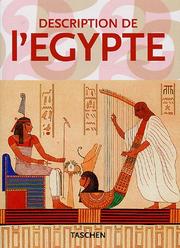
ISBN: 9783822837757 382283775X Year: 2007 Publisher: Köln Taschen
Abstract | Keywords | Export | Availability | Bookmark
 Loading...
Loading...Choose an application
- Reference Manager
- EndNote
- RefWorks (Direct export to RefWorks)
Book history --- Archeology --- anno 1800-1899 --- Egypt --- 094:910.4 --- Oude en merkwaardige drukken. Kostbare en zeldzame boeken. Preciosa en rariora-:-Ontdekkingsreizen. Reizen. Expedities. Reisverhalen --- 094:910.4 Oude en merkwaardige drukken. Kostbare en zeldzame boeken. Preciosa en rariora-:-Ontdekkingsreizen. Reizen. Expedities. Reisverhalen --- Art, Egyptian --- Architecture, Egyptian --- Natural history --- Antiquities --- Architecture, Egyptian - Pictorial works --- Natural history - Egypt - Pictorial works --- Egypt - Antiquities - Pictorial works
Book
ISBN: 9783447056328 3447056320 Year: 2008 Volume: 21 Publisher: Wiesbaden : Harrassowitz,
Abstract | Keywords | Export | Availability | Bookmark
 Loading...
Loading...Choose an application
- Reference Manager
- EndNote
- RefWorks (Direct export to RefWorks)
Die altägyptische Medizin des 2. Jahrtausend v. Chr. Galt als die beste ihrer Zeit im gesamten östlichen Mittelmeerraum und Mesopotamien. Ihre Wertschätzung beruhte vor allem auf dem umfangreichen Wissen der ägyptischen Ärzte um die Heilkraft von Arzneimittelpflanzen. Diese, auf empirischem Wege erlangten Kenntnisse, sind uns in zahlreichen Papyri überliefert. Der erste Teil des Bandes listet die in den altägyptischen Papyri genannten Pflanzenprodukte auf. Anhand kurzer, ins Deutsche übersetzter Textpassagen wird für jedes die medizinische Verwendung dokumentiert. Dabei lassen sich für viele Materialien Anwendungsschwerpunkte erkennen, die Rückschlüsse auf ihre pharmazeutische Wirkung erlauben. Die botanische Identifizierung der einzelnen Heilpflanzen ist jedoch bis heute nur zu einem geringen Teil möglich. Um dennoch einen Einblick in den möglichen und auch wahrscheinlichen altägyptischen Heilpflanzenschatz zu gewinnen, werden im zweiten Teil des Bandes die Pflanzen vorgestellt, die in der neuzeitlichen ägyptischen Volksmedizin eine Rolle spielen. Als Quelle dienen dafür die Schriften Prosper Alpins aus dem 16. Jahrhundert und die neusten Forschungen zu den noch heute in Ägypten genutzten Arzneimittelpflanzen. Soweit es möglich ist, sind den einzelnen Pflanzen noch Informationen zu ihrer Verwendung in der koptischen Heilkunde und Erwähnung bei Plinius und Dioskurides beigefügt. Basierend auf den archäobotanischen Arbeiten der letzten Jahre wird überprüft, ob die jeweilige Heilpflanze zur heimischen Flora Ägyptens gehört oder durch Handelsbeziehungen bereits im 2. Jahrtausend v. Chr. für die Ärzte erreichbar war.
Botany, Medical --- Medicinal plants --- Drug plants --- Medical botany --- History --- Plants, Useful --- Botanical drug industry --- Materia medica, Vegetable --- Psychotropic plants --- Botany --- Medical sciences --- Medical botanists --- Phytotherapy --- History, Ancient --- Plants, Medicinal --- history --- Botany, Medical - Egypt - History --- Medicinal plants - Egypt - Handbooks, manuals, etc --- Phytotherapy - history - Egypt --- History, Ancient - Egypt. --- Plants, Medicinal - Egypt. --- Plantes médicinales --- Égypte --- Guides, manuels, etc.
Book
ISBN: 022663275X Year: 2020 Publisher: Chicago, Illinois ; London : The University of Chicago Press,
Abstract | Keywords | Export | Availability | Bookmark
 Loading...
Loading...Choose an application
- Reference Manager
- EndNote
- RefWorks (Direct export to RefWorks)
How have ruins become so valued in Western culture and so central to our art and literature? Covering a vast chronological and geographical range, from ancient Egyptian inscriptions to twentieth-century memorials, Susan Stewart seeks to answer this question as she traces the appeal of ruins and ruins images, and the lessons that writers and artists have drawn from their haunting forms. Stewart takes us on a sweeping journey through founding legends of broken covenants and original sin, the Christian appropriation of the classical past, myths and rituals of fertility, images of decay in early modern allegory and melancholy, the ruins craze of the eighteenth century, and the creation of “new ruins” for gardens and other structures. Stewart focuses particularly on Renaissance humanism and Romanticism, periods of intense interest in ruins that also offer new frames for their perception. The Ruins Lesson looks in depth at the works of Goethe, Piranesi, Blake, and Wordsworth, each of whom found in ruins a means of reinventing art. Ruins, Stewart concludes, arise at the boundaries of cultures and civilizations. Their very appearance depends upon an act of translation between the past and the present, between those who have vanished and those who emerge. Lively and engaging, The Ruins Lesson ultimately asks what can resist ruination—and finds in the self-transforming, ever-fleeting practices of language and thought a clue to what might truly endure.
Ruins in literature. --- Ruins in art. --- Antiquities in literature. --- Antiquities in art. --- ruins, art, history, egypt, legend, wordsworth, blake, piranesi, goethe, decay, classicism, christianity, religion, inscriptions, memorials, allegory, original sin, ruination, transformation, antiquities, spolia, women, gender, sexuality, virtue, nymph, whore, virgin, humanism, architecture, trauma, destruction, humanities, renaissance, memory, romanticism, literature, painting, printmaking, iconoclasm, monument, aesthetics, death, nonfiction, preservation, obliteration, parlanti ruine, materiality, endurance, transience. --- ruins, art, history, egypt, legend, wordsworth, blake, piranesi, goethe, decay, classicism, christianity, religion, inscriptions, memorials, allegory, original sin, ruination, transformation, antiquities, spolia, women, gender, sexuality, virtue, nymph, whore, virgin, humanism, architecture, trauma, destruction, humanities, renaissance, memory, romanticism, literature, painting, printmaking, iconoclasm, monument, aesthetics, death, nonfiction, preservation, obliteration, parlanti ruine, materiality, endurance, transience.
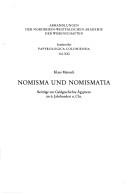
ISBN: 3531099353 3322842045 9783531099354 Year: 1994 Volume: 21 Publisher: Köln ; Opladen : Westdeutscher Verlag,
Abstract | Keywords | Export | Availability | Bookmark
 Loading...
Loading...Choose an application
- Reference Manager
- EndNote
- RefWorks (Direct export to RefWorks)
Manuscripts, Greek (Papyri) --- Money --- -History --- -Manuscripts, Greek (Papyri) --- Manuscripts, Greek --- -Greek manuscripts --- Greek language --- Greek philology --- Greek papyri --- Papyri, Greek --- Manuscripts, Classical (Papyri) --- Manuscripts (Papyri) --- Currency --- Monetary question --- Money, Primitive --- Specie --- Standard of value --- Exchange --- Finance --- Value --- Banks and banking --- Coinage --- Currency question --- Gold --- Silver --- Silver question --- Wealth --- History --- Sources. --- -Greek papyri --- Greek manuscripts --- History&delete& --- Sources --- Manuscripts, Greek (Papyri) - Egypt --- Money - - History - Egypt --- -Money

ISBN: 9004103198 9004113207 9004113215 9004294074 9789004103191 Year: 1999 Volume: 36 Publisher: Leiden : E.J. Brill,
Abstract | Keywords | Export | Availability | Bookmark
 Loading...
Loading...Choose an application
- Reference Manager
- EndNote
- RefWorks (Direct export to RefWorks)
Some 25 years ago the famous nine-volume Grundrisz der Medizin der alten Ägypter by Hildegard von Deines e.a. (editions.) saw the light. One of the editors was Professor Dr. Wolfhart Westendorf, the author of the new Handbuch der altägyptischen Medizin now published in Brill's series Handbook of Oriental Studies. At last the present handbook offers the readership an abridged and revised edition of the old Grundrisz . It deals with Ancient Egyptian Medicine from the second millennium up to the Roman period. In selecting the material for this volume the author based himself not only on the extant papyrus texts (both hieratic and demotic), but also on relevant passages from Egyptian literature like magical texts and ostraka and on archaeological evidence (mummies, represenations of patients). After an Introduction (science, religion, magic), there are chapters on sources, formal organisation of the underlying texts, patients and diseases, the physician (profession, social status, title, methods of treatment, dealing with drugs, using magic power, et cetera) on the end of Egyptian medicine in Coptic and Greek medicine, and the Ebers and Smith Papyri (with translations). The work concludes with extensive indices (places, themes, et cetera)
Medicine, Egyptian --- Manuscripts (Papyri) --- Médecine égyptienne --- Papyrus (Manuscrits) --- History --- Handbooks, manuals, etc. --- Histoire --- Guides, manuels, etc --- 61 <32> --- 610.932 --- Geneeskunde. Hygiëne. Farmacie--Oud-Egypte --- Technology Medicine History Egypt --- 61 <09> --- 61 <09> Geschiedenis van de geneeskunde --- Geschiedenis van de geneeskunde --- Egyptian medicine --- Medicine, Ancient --- Medicine, Oriental --- Papyri, Egyptian --- Papyrus manuscripts --- Paleography --- Writing materials and instruments --- Handbooks, manuals, etc --- History&delete& --- 61 <09> History of medicine --- History of medicine --- Egyptians --- Medicine --- Medicine, Egyptian.
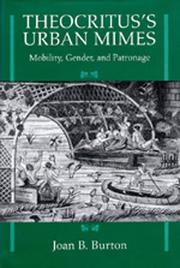
ISBN: 0520088581 0585154848 9780520088580 Year: 1995 Volume: 19 Publisher: Berkeley University of California press
Abstract | Keywords | Export | Availability | Bookmark
 Loading...
Loading...Choose an application
- Reference Manager
- EndNote
- RefWorks (Direct export to RefWorks)
Women and literature --- Art and state --- Authors and patrons --- Greek poetry, Hellenistic --- Social mobility in literature --- Literature and society --- -Sex role in literature --- History --- History and criticism --- Theocritus --- Political and social views --- -Art and state --- -Authors and patrons --- -Greek poetry, Hellenistic --- -Literature and society --- Literature --- Literature and sociology --- Society and literature --- Sociology and literature --- Sociolinguistics --- Hellenistic Greek poetry --- Greek literature, Hellenistic --- Literary patronage --- Maecenatism --- Patronage of literature --- Sponsorship of literature --- Art patronage --- Literary patrons --- Literature and state --- Art --- Arts --- Politics and art --- State and art --- Art and society --- Cultural policy --- Education and state --- Social aspects --- Government policy --- -Theocritus --- -Théocrite --- Theokritos --- Views on sex role --- Social mobility in literature. --- Sex role in literature. --- Poésie grecque hellénistique --- -Littérature et société --- Femmes et littérature --- Ecrivains et mécènes --- Mobilité sociale dans la littérature --- Rôle selon le sexe dans la littérature --- History and criticism. --- Histoire et critique --- Alexandrie --- Histoire --- Politique gouvernementale --- Mimes --- Sex role in literature --- Mime artists --- Actors --- Benefactors --- Théocrite --- Political and social views. --- History. --- Women and literature - History - Egypt - Alexandria --- -Art and state - History - Egypt - - Alexandria --- -Authors and patrons - History - Egypt - - Alexandria --- -Greek poetry, Hellenistic - History and criticism - Egypt - - Alexandria --- -Social mobility in literature --- Literature and society - Egypt - Alexandria - History --- Theocritus - Political and social views --- Greek & Latin Languages & Literatures --- Languages & Literatures
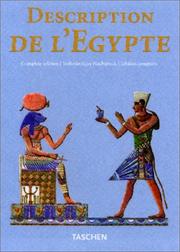
ISBN: 3822889644 9783822889640 Year: 1997 Publisher: Cologne Taschen
Abstract | Keywords | Export | Availability | Bookmark
 Loading...
Loading...Choose an application
- Reference Manager
- EndNote
- RefWorks (Direct export to RefWorks)
Art, Egyptian. --- Architecture, Egyptian --- Natural history --- Art égyptien --- Architecture égyptienne --- Sciences naturelles --- Pictorial works. --- Ouvrages illustrés --- Egypt --- Egypte --- Histoire de l'art --- Egyptologie --- 7.032.2 --- Kunstgeschiedenis Oud-Egyptische kunst --- Art égyptien --- Architecture égyptienne --- Ouvrages illustrés --- Art, Egyptian --- History, Natural --- Natural science --- Physiophilosophy --- Biology --- Science --- Egyptian art --- Egyptian architecture --- Kunstgeschiedenis ; Oud-Egyptische kunst --- Égypte --- Ägypten --- Egitto --- Egipet --- Egiptos --- Miṣr --- Southern Region (United Arab Republic) --- Egyptian Region (United Arab Republic) --- Iqlīm al-Janūbī (United Arab Republic) --- Egyptian Territory (United Arab Republic) --- Egipat --- Arab Republic of Egypt --- A.R.E. --- ARE (Arab Republic of Egypt) --- Jumhūrīyat Miṣr al-ʻArabīyah --- Mitsrayim --- Egipt --- Ijiptʻŭ --- Misri --- Ancient Egypt --- Gouvernement royal égyptien --- جمهورية مصر العربية --- مِصر --- مَصر --- Maṣr --- Khēmi --- エジプト --- Ejiputo --- Egypti --- Egypten --- מצרים --- United Arab Republic --- Antiquities --- Architecture, Egyptian - Pictorial works. --- Natural history - Egypt - Pictorial works. --- Antiquites --- Ouvrages illustres --- Descriptions et voyages --- 1789-1815
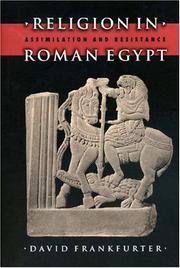
ISBN: 0691026858 0691070547 9780691026855 9780691070544 0691214735 Year: 1998 Publisher: Princeton : Princeton University Press,
Abstract | Keywords | Export | Availability | Bookmark
 Loading...
Loading...Choose an application
- Reference Manager
- EndNote
- RefWorks (Direct export to RefWorks)
This exploration of cultural resilience examines the complex fate of classical Egyptian religion during the centuries from the period when Christianity first made its appearance in Egypt to when it became the region's dominant religion (roughly 100 to 600 C.E. Taking into account the full range of witnesses to continuing native piety--from papyri and saints' lives to archaeology and terracotta figurines--and drawing on anthropological studies of folk religion, David Frankfurter argues that the religion of Pharonic Egypt did not die out as early as has been supposed but was instead relegated from political centers to village and home, where it continued a vigorous existence for centuries. In analyzing the fate of the Egyptian oracle and of the priesthoods, the function of magical texts, and the dynamics of domestic cults, Frankfurter describes how an ancient culture maintained itself while also being transformed through influences such as Hellenism, Roman government, and Christian dominance. Recognizing the special characteristics of Egypt, which differentiated it from the other Mediterranean cultures that were undergoing simultaneous social and political changes, he departs from the traditional "decline of paganism/triumph of Christianity" model most often used to describe the Roman period. By revealing late Egyptian religion in its Egyptian historical context, he moves us away from scenarios of Christian triumph and shows us how long and how energetically pagan worship survived.
Egyptische godsdienst. --- Vroege christendom. --- Egypte. --- Egyptian --- Religion égyptienne --- -200.932 --- -Egyptian --- Religion History Egypt --- Religion égyptienne --- 299.31 --- Egypt --- -Christianity and other religions --- Christianity --- Christianity and other religions --- Syncretism (Christianity) --- 299.31 Godsdiensten van de Oude Egyptenaren --- Godsdiensten van de Oude Egyptenaren --- Religion --- Relations --- History --- 200.932 --- Christianisme --- Egypte --- 332 B.C.-638 A.D. --- Egypt - Religion - 332 B.C.-640 A.D. --- Christianity and other religions - Egyptian. --- RELIGION / History. --- Abydos. --- Ammianus Marcellinus. --- Apis bull. --- Atripe. --- Bes. --- Blemmyes. --- Canopus (Delta). --- Edfu. --- Eunapius. --- Gesios. --- Harpocrates. --- Hermetica. --- Herodotus. --- Horus. --- Jews and Judaism. --- John of Lycopolis. --- Libanius of Antioch. --- Lucian. --- Mandulis. --- Manichaeism. --- Min (Pan). --- Osiris. --- Paphnuti. --- Petbe. --- Plutarch. --- Re-Harmachis. --- Rufinus. --- Seth (Typhon). --- Syria. --- amulets. --- demons and demonology. --- domestic religion. --- exorcism. --- festivals. --- hagiography. --- healing and healers. --- naoi. --- oracles. --- terracotta figurines.
| Listing 1 - 10 of 10 |
Sort by
|

 Search
Search Feedback
Feedback About UniCat
About UniCat  Help
Help News
News